Keeping Children Away From Harm
VerifiedAdded on 2023/03/31
|12
|4068
|318
AI Summary
This assignment focuses on a case study to understand the importance of child safety and the different measures, which should be taken to keep the child safe and away from any harm, that is, physical abuse, psychological abuse, sexual abuse, neglect abuse, and emotional abuse.
Contribute Materials
Your contribution can guide someone’s learning journey. Share your
documents today.
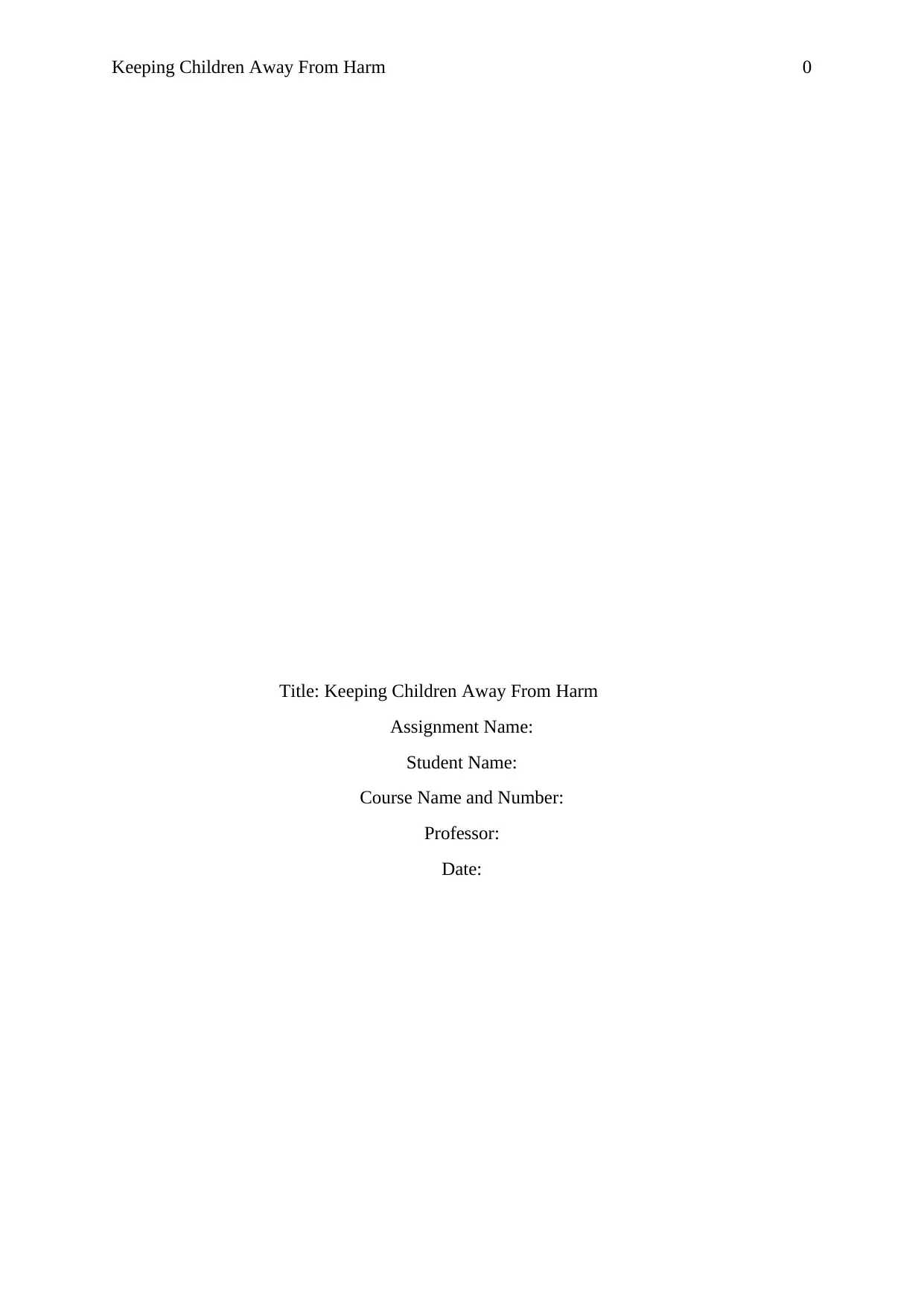
Keeping Children Away From Harm 0
Title: Keeping Children Away From Harm
Assignment Name:
Student Name:
Course Name and Number:
Professor:
Date:
Title: Keeping Children Away From Harm
Assignment Name:
Student Name:
Course Name and Number:
Professor:
Date:
Secure Best Marks with AI Grader
Need help grading? Try our AI Grader for instant feedback on your assignments.
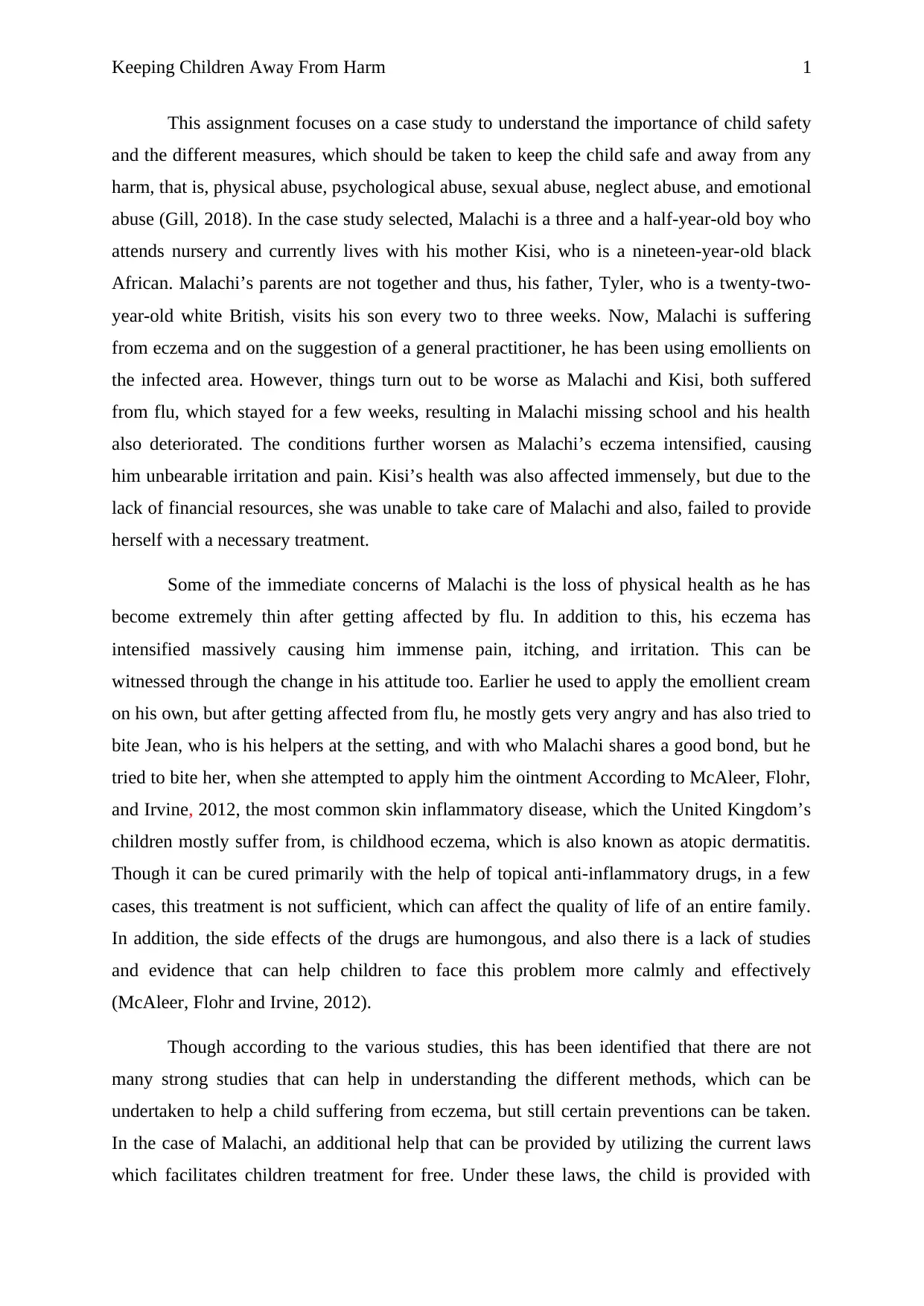
Keeping Children Away From Harm 1
This assignment focuses on a case study to understand the importance of child safety
and the different measures, which should be taken to keep the child safe and away from any
harm, that is, physical abuse, psychological abuse, sexual abuse, neglect abuse, and emotional
abuse (Gill, 2018). In the case study selected, Malachi is a three and a half-year-old boy who
attends nursery and currently lives with his mother Kisi, who is a nineteen-year-old black
African. Malachi’s parents are not together and thus, his father, Tyler, who is a twenty-two-
year-old white British, visits his son every two to three weeks. Now, Malachi is suffering
from eczema and on the suggestion of a general practitioner, he has been using emollients on
the infected area. However, things turn out to be worse as Malachi and Kisi, both suffered
from flu, which stayed for a few weeks, resulting in Malachi missing school and his health
also deteriorated. The conditions further worsen as Malachi’s eczema intensified, causing
him unbearable irritation and pain. Kisi’s health was also affected immensely, but due to the
lack of financial resources, she was unable to take care of Malachi and also, failed to provide
herself with a necessary treatment.
Some of the immediate concerns of Malachi is the loss of physical health as he has
become extremely thin after getting affected by flu. In addition to this, his eczema has
intensified massively causing him immense pain, itching, and irritation. This can be
witnessed through the change in his attitude too. Earlier he used to apply the emollient cream
on his own, but after getting affected from flu, he mostly gets very angry and has also tried to
bite Jean, who is his helpers at the setting, and with who Malachi shares a good bond, but he
tried to bite her, when she attempted to apply him the ointment According to McAleer, Flohr,
and Irvine, 2012, the most common skin inflammatory disease, which the United Kingdom’s
children mostly suffer from, is childhood eczema, which is also known as atopic dermatitis.
Though it can be cured primarily with the help of topical anti-inflammatory drugs, in a few
cases, this treatment is not sufficient, which can affect the quality of life of an entire family.
In addition, the side effects of the drugs are humongous, and also there is a lack of studies
and evidence that can help children to face this problem more calmly and effectively
(McAleer, Flohr and Irvine, 2012).
Though according to the various studies, this has been identified that there are not
many strong studies that can help in understanding the different methods, which can be
undertaken to help a child suffering from eczema, but still certain preventions can be taken.
In the case of Malachi, an additional help that can be provided by utilizing the current laws
which facilitates children treatment for free. Under these laws, the child is provided with
This assignment focuses on a case study to understand the importance of child safety
and the different measures, which should be taken to keep the child safe and away from any
harm, that is, physical abuse, psychological abuse, sexual abuse, neglect abuse, and emotional
abuse (Gill, 2018). In the case study selected, Malachi is a three and a half-year-old boy who
attends nursery and currently lives with his mother Kisi, who is a nineteen-year-old black
African. Malachi’s parents are not together and thus, his father, Tyler, who is a twenty-two-
year-old white British, visits his son every two to three weeks. Now, Malachi is suffering
from eczema and on the suggestion of a general practitioner, he has been using emollients on
the infected area. However, things turn out to be worse as Malachi and Kisi, both suffered
from flu, which stayed for a few weeks, resulting in Malachi missing school and his health
also deteriorated. The conditions further worsen as Malachi’s eczema intensified, causing
him unbearable irritation and pain. Kisi’s health was also affected immensely, but due to the
lack of financial resources, she was unable to take care of Malachi and also, failed to provide
herself with a necessary treatment.
Some of the immediate concerns of Malachi is the loss of physical health as he has
become extremely thin after getting affected by flu. In addition to this, his eczema has
intensified massively causing him immense pain, itching, and irritation. This can be
witnessed through the change in his attitude too. Earlier he used to apply the emollient cream
on his own, but after getting affected from flu, he mostly gets very angry and has also tried to
bite Jean, who is his helpers at the setting, and with who Malachi shares a good bond, but he
tried to bite her, when she attempted to apply him the ointment According to McAleer, Flohr,
and Irvine, 2012, the most common skin inflammatory disease, which the United Kingdom’s
children mostly suffer from, is childhood eczema, which is also known as atopic dermatitis.
Though it can be cured primarily with the help of topical anti-inflammatory drugs, in a few
cases, this treatment is not sufficient, which can affect the quality of life of an entire family.
In addition, the side effects of the drugs are humongous, and also there is a lack of studies
and evidence that can help children to face this problem more calmly and effectively
(McAleer, Flohr and Irvine, 2012).
Though according to the various studies, this has been identified that there are not
many strong studies that can help in understanding the different methods, which can be
undertaken to help a child suffering from eczema, but still certain preventions can be taken.
In the case of Malachi, an additional help that can be provided by utilizing the current laws
which facilitates children treatment for free. Under these laws, the child is provided with
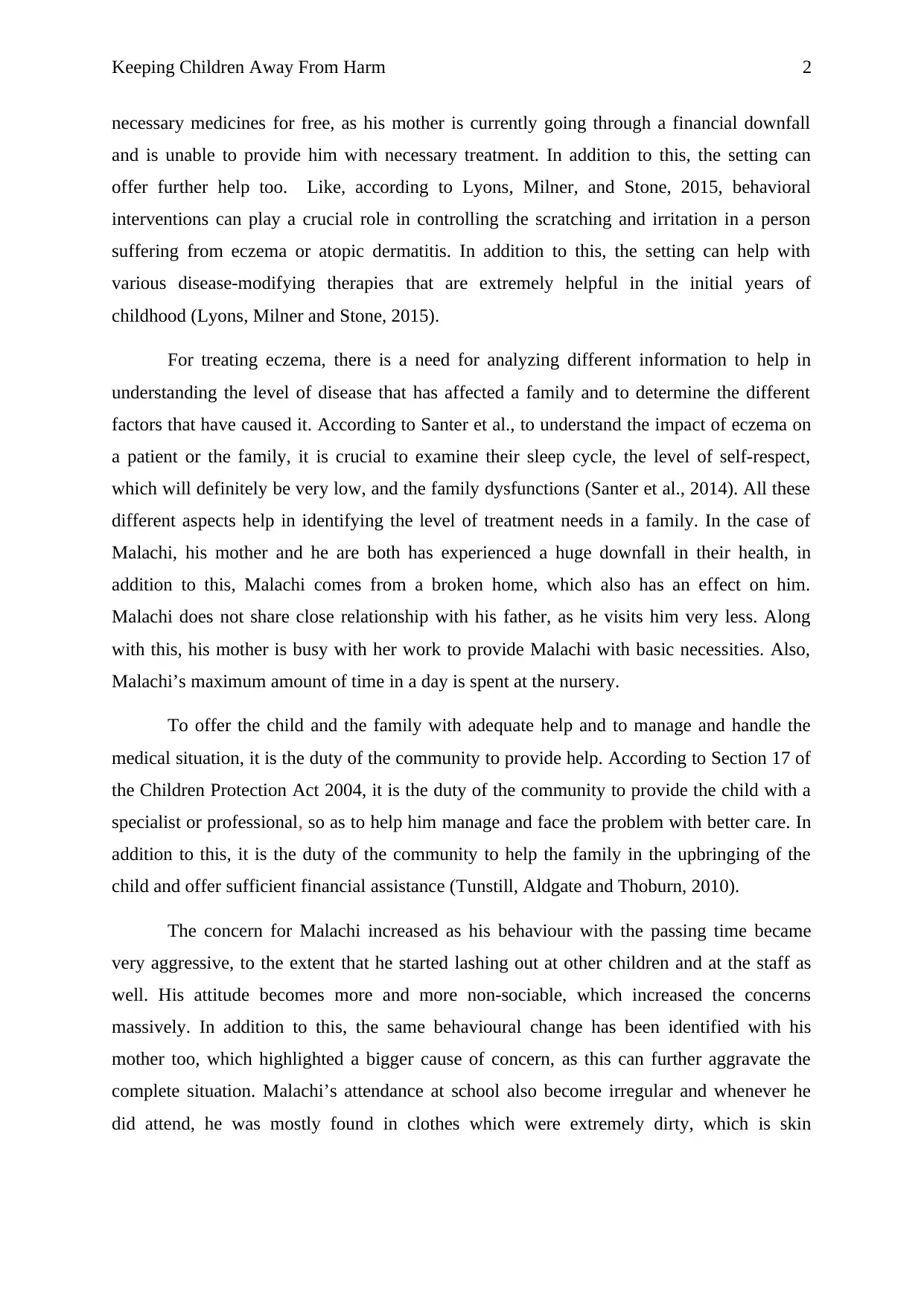
Keeping Children Away From Harm 2
necessary medicines for free, as his mother is currently going through a financial downfall
and is unable to provide him with necessary treatment. In addition to this, the setting can
offer further help too. Like, according to Lyons, Milner, and Stone, 2015, behavioral
interventions can play a crucial role in controlling the scratching and irritation in a person
suffering from eczema or atopic dermatitis. In addition to this, the setting can help with
various disease-modifying therapies that are extremely helpful in the initial years of
childhood (Lyons, Milner and Stone, 2015).
For treating eczema, there is a need for analyzing different information to help in
understanding the level of disease that has affected a family and to determine the different
factors that have caused it. According to Santer et al., to understand the impact of eczema on
a patient or the family, it is crucial to examine their sleep cycle, the level of self-respect,
which will definitely be very low, and the family dysfunctions (Santer et al., 2014). All these
different aspects help in identifying the level of treatment needs in a family. In the case of
Malachi, his mother and he are both has experienced a huge downfall in their health, in
addition to this, Malachi comes from a broken home, which also has an effect on him.
Malachi does not share close relationship with his father, as he visits him very less. Along
with this, his mother is busy with her work to provide Malachi with basic necessities. Also,
Malachi’s maximum amount of time in a day is spent at the nursery.
To offer the child and the family with adequate help and to manage and handle the
medical situation, it is the duty of the community to provide help. According to Section 17 of
the Children Protection Act 2004, it is the duty of the community to provide the child with a
specialist or professional, so as to help him manage and face the problem with better care. In
addition to this, it is the duty of the community to help the family in the upbringing of the
child and offer sufficient financial assistance (Tunstill, Aldgate and Thoburn, 2010).
The concern for Malachi increased as his behaviour with the passing time became
very aggressive, to the extent that he started lashing out at other children and at the staff as
well. His attitude becomes more and more non-sociable, which increased the concerns
massively. In addition to this, the same behavioural change has been identified with his
mother too, which highlighted a bigger cause of concern, as this can further aggravate the
complete situation. Malachi’s attendance at school also become irregular and whenever he
did attend, he was mostly found in clothes which were extremely dirty, which is skin
necessary medicines for free, as his mother is currently going through a financial downfall
and is unable to provide him with necessary treatment. In addition to this, the setting can
offer further help too. Like, according to Lyons, Milner, and Stone, 2015, behavioral
interventions can play a crucial role in controlling the scratching and irritation in a person
suffering from eczema or atopic dermatitis. In addition to this, the setting can help with
various disease-modifying therapies that are extremely helpful in the initial years of
childhood (Lyons, Milner and Stone, 2015).
For treating eczema, there is a need for analyzing different information to help in
understanding the level of disease that has affected a family and to determine the different
factors that have caused it. According to Santer et al., to understand the impact of eczema on
a patient or the family, it is crucial to examine their sleep cycle, the level of self-respect,
which will definitely be very low, and the family dysfunctions (Santer et al., 2014). All these
different aspects help in identifying the level of treatment needs in a family. In the case of
Malachi, his mother and he are both has experienced a huge downfall in their health, in
addition to this, Malachi comes from a broken home, which also has an effect on him.
Malachi does not share close relationship with his father, as he visits him very less. Along
with this, his mother is busy with her work to provide Malachi with basic necessities. Also,
Malachi’s maximum amount of time in a day is spent at the nursery.
To offer the child and the family with adequate help and to manage and handle the
medical situation, it is the duty of the community to provide help. According to Section 17 of
the Children Protection Act 2004, it is the duty of the community to provide the child with a
specialist or professional, so as to help him manage and face the problem with better care. In
addition to this, it is the duty of the community to help the family in the upbringing of the
child and offer sufficient financial assistance (Tunstill, Aldgate and Thoburn, 2010).
The concern for Malachi increased as his behaviour with the passing time became
very aggressive, to the extent that he started lashing out at other children and at the staff as
well. His attitude becomes more and more non-sociable, which increased the concerns
massively. In addition to this, the same behavioural change has been identified with his
mother too, which highlighted a bigger cause of concern, as this can further aggravate the
complete situation. Malachi’s attendance at school also become irregular and whenever he
did attend, he was mostly found in clothes which were extremely dirty, which is skin
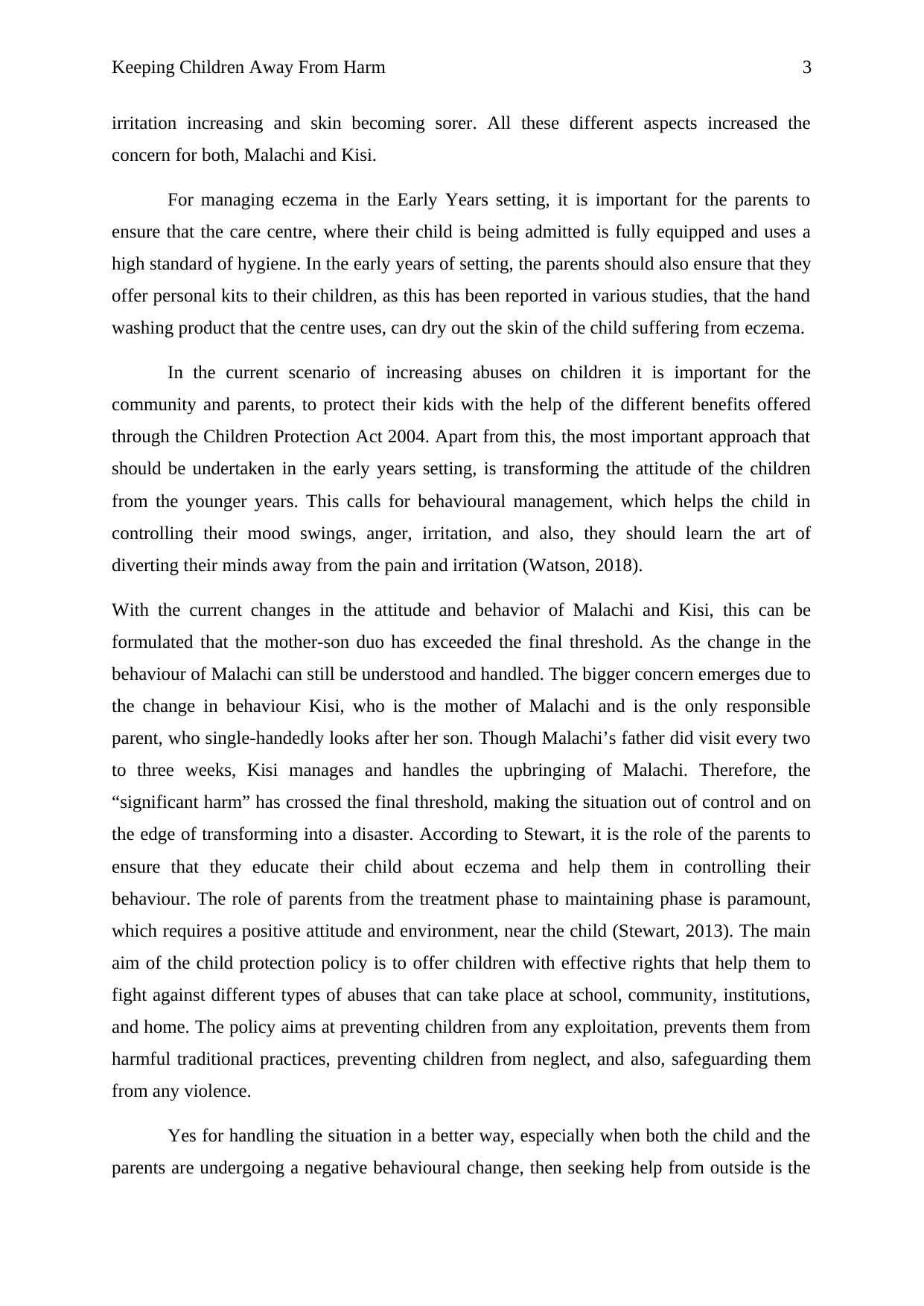
Keeping Children Away From Harm 3
irritation increasing and skin becoming sorer. All these different aspects increased the
concern for both, Malachi and Kisi.
For managing eczema in the Early Years setting, it is important for the parents to
ensure that the care centre, where their child is being admitted is fully equipped and uses a
high standard of hygiene. In the early years of setting, the parents should also ensure that they
offer personal kits to their children, as this has been reported in various studies, that the hand
washing product that the centre uses, can dry out the skin of the child suffering from eczema.
In the current scenario of increasing abuses on children it is important for the
community and parents, to protect their kids with the help of the different benefits offered
through the Children Protection Act 2004. Apart from this, the most important approach that
should be undertaken in the early years setting, is transforming the attitude of the children
from the younger years. This calls for behavioural management, which helps the child in
controlling their mood swings, anger, irritation, and also, they should learn the art of
diverting their minds away from the pain and irritation (Watson, 2018).
With the current changes in the attitude and behavior of Malachi and Kisi, this can be
formulated that the mother-son duo has exceeded the final threshold. As the change in the
behaviour of Malachi can still be understood and handled. The bigger concern emerges due to
the change in behaviour Kisi, who is the mother of Malachi and is the only responsible
parent, who single-handedly looks after her son. Though Malachi’s father did visit every two
to three weeks, Kisi manages and handles the upbringing of Malachi. Therefore, the
“significant harm” has crossed the final threshold, making the situation out of control and on
the edge of transforming into a disaster. According to Stewart, it is the role of the parents to
ensure that they educate their child about eczema and help them in controlling their
behaviour. The role of parents from the treatment phase to maintaining phase is paramount,
which requires a positive attitude and environment, near the child (Stewart, 2013). The main
aim of the child protection policy is to offer children with effective rights that help them to
fight against different types of abuses that can take place at school, community, institutions,
and home. The policy aims at preventing children from any exploitation, prevents them from
harmful traditional practices, preventing children from neglect, and also, safeguarding them
from any violence.
Yes for handling the situation in a better way, especially when both the child and the
parents are undergoing a negative behavioural change, then seeking help from outside is the
irritation increasing and skin becoming sorer. All these different aspects increased the
concern for both, Malachi and Kisi.
For managing eczema in the Early Years setting, it is important for the parents to
ensure that the care centre, where their child is being admitted is fully equipped and uses a
high standard of hygiene. In the early years of setting, the parents should also ensure that they
offer personal kits to their children, as this has been reported in various studies, that the hand
washing product that the centre uses, can dry out the skin of the child suffering from eczema.
In the current scenario of increasing abuses on children it is important for the
community and parents, to protect their kids with the help of the different benefits offered
through the Children Protection Act 2004. Apart from this, the most important approach that
should be undertaken in the early years setting, is transforming the attitude of the children
from the younger years. This calls for behavioural management, which helps the child in
controlling their mood swings, anger, irritation, and also, they should learn the art of
diverting their minds away from the pain and irritation (Watson, 2018).
With the current changes in the attitude and behavior of Malachi and Kisi, this can be
formulated that the mother-son duo has exceeded the final threshold. As the change in the
behaviour of Malachi can still be understood and handled. The bigger concern emerges due to
the change in behaviour Kisi, who is the mother of Malachi and is the only responsible
parent, who single-handedly looks after her son. Though Malachi’s father did visit every two
to three weeks, Kisi manages and handles the upbringing of Malachi. Therefore, the
“significant harm” has crossed the final threshold, making the situation out of control and on
the edge of transforming into a disaster. According to Stewart, it is the role of the parents to
ensure that they educate their child about eczema and help them in controlling their
behaviour. The role of parents from the treatment phase to maintaining phase is paramount,
which requires a positive attitude and environment, near the child (Stewart, 2013). The main
aim of the child protection policy is to offer children with effective rights that help them to
fight against different types of abuses that can take place at school, community, institutions,
and home. The policy aims at preventing children from any exploitation, prevents them from
harmful traditional practices, preventing children from neglect, and also, safeguarding them
from any violence.
Yes for handling the situation in a better way, especially when both the child and the
parents are undergoing a negative behavioural change, then seeking help from outside is the
Secure Best Marks with AI Grader
Need help grading? Try our AI Grader for instant feedback on your assignments.
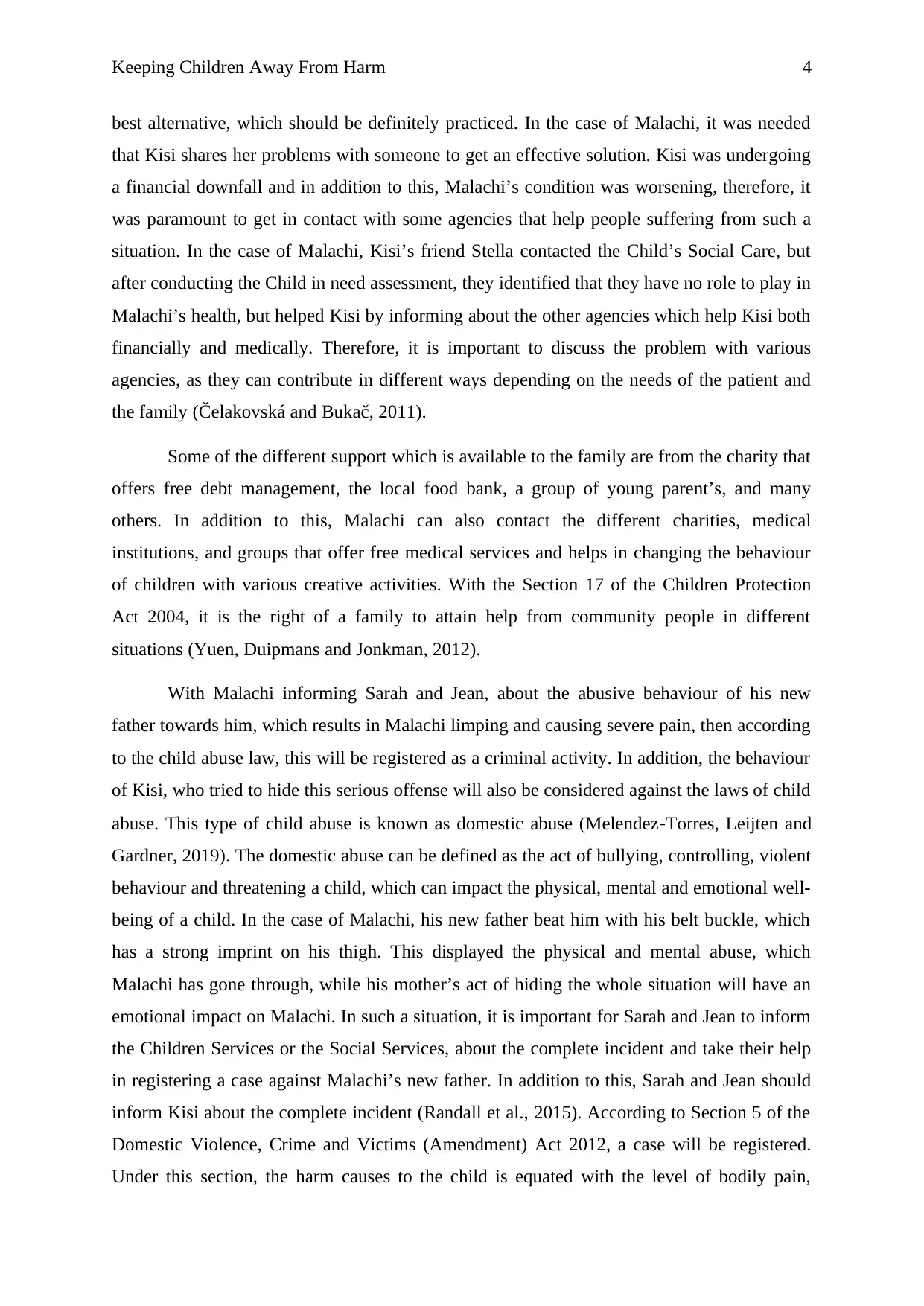
Keeping Children Away From Harm 4
best alternative, which should be definitely practiced. In the case of Malachi, it was needed
that Kisi shares her problems with someone to get an effective solution. Kisi was undergoing
a financial downfall and in addition to this, Malachi’s condition was worsening, therefore, it
was paramount to get in contact with some agencies that help people suffering from such a
situation. In the case of Malachi, Kisi’s friend Stella contacted the Child’s Social Care, but
after conducting the Child in need assessment, they identified that they have no role to play in
Malachi’s health, but helped Kisi by informing about the other agencies which help Kisi both
financially and medically. Therefore, it is important to discuss the problem with various
agencies, as they can contribute in different ways depending on the needs of the patient and
the family (Čelakovská and Bukač, 2011).
Some of the different support which is available to the family are from the charity that
offers free debt management, the local food bank, a group of young parent’s, and many
others. In addition to this, Malachi can also contact the different charities, medical
institutions, and groups that offer free medical services and helps in changing the behaviour
of children with various creative activities. With the Section 17 of the Children Protection
Act 2004, it is the right of a family to attain help from community people in different
situations (Yuen, Duipmans and Jonkman, 2012).
With Malachi informing Sarah and Jean, about the abusive behaviour of his new
father towards him, which results in Malachi limping and causing severe pain, then according
to the child abuse law, this will be registered as a criminal activity. In addition, the behaviour
of Kisi, who tried to hide this serious offense will also be considered against the laws of child
abuse. This type of child abuse is known as domestic abuse (Melendez‐Torres, Leijten and
Gardner, 2019). The domestic abuse can be defined as the act of bullying, controlling, violent
behaviour and threatening a child, which can impact the physical, mental and emotional well-
being of a child. In the case of Malachi, his new father beat him with his belt buckle, which
has a strong imprint on his thigh. This displayed the physical and mental abuse, which
Malachi has gone through, while his mother’s act of hiding the whole situation will have an
emotional impact on Malachi. In such a situation, it is important for Sarah and Jean to inform
the Children Services or the Social Services, about the complete incident and take their help
in registering a case against Malachi’s new father. In addition to this, Sarah and Jean should
inform Kisi about the complete incident (Randall et al., 2015). According to Section 5 of the
Domestic Violence, Crime and Victims (Amendment) Act 2012, a case will be registered.
Under this section, the harm causes to the child is equated with the level of bodily pain,
best alternative, which should be definitely practiced. In the case of Malachi, it was needed
that Kisi shares her problems with someone to get an effective solution. Kisi was undergoing
a financial downfall and in addition to this, Malachi’s condition was worsening, therefore, it
was paramount to get in contact with some agencies that help people suffering from such a
situation. In the case of Malachi, Kisi’s friend Stella contacted the Child’s Social Care, but
after conducting the Child in need assessment, they identified that they have no role to play in
Malachi’s health, but helped Kisi by informing about the other agencies which help Kisi both
financially and medically. Therefore, it is important to discuss the problem with various
agencies, as they can contribute in different ways depending on the needs of the patient and
the family (Čelakovská and Bukač, 2011).
Some of the different support which is available to the family are from the charity that
offers free debt management, the local food bank, a group of young parent’s, and many
others. In addition to this, Malachi can also contact the different charities, medical
institutions, and groups that offer free medical services and helps in changing the behaviour
of children with various creative activities. With the Section 17 of the Children Protection
Act 2004, it is the right of a family to attain help from community people in different
situations (Yuen, Duipmans and Jonkman, 2012).
With Malachi informing Sarah and Jean, about the abusive behaviour of his new
father towards him, which results in Malachi limping and causing severe pain, then according
to the child abuse law, this will be registered as a criminal activity. In addition, the behaviour
of Kisi, who tried to hide this serious offense will also be considered against the laws of child
abuse. This type of child abuse is known as domestic abuse (Melendez‐Torres, Leijten and
Gardner, 2019). The domestic abuse can be defined as the act of bullying, controlling, violent
behaviour and threatening a child, which can impact the physical, mental and emotional well-
being of a child. In the case of Malachi, his new father beat him with his belt buckle, which
has a strong imprint on his thigh. This displayed the physical and mental abuse, which
Malachi has gone through, while his mother’s act of hiding the whole situation will have an
emotional impact on Malachi. In such a situation, it is important for Sarah and Jean to inform
the Children Services or the Social Services, about the complete incident and take their help
in registering a case against Malachi’s new father. In addition to this, Sarah and Jean should
inform Kisi about the complete incident (Randall et al., 2015). According to Section 5 of the
Domestic Violence, Crime and Victims (Amendment) Act 2012, a case will be registered.
Under this section, the harm causes to the child is equated with the level of bodily pain,
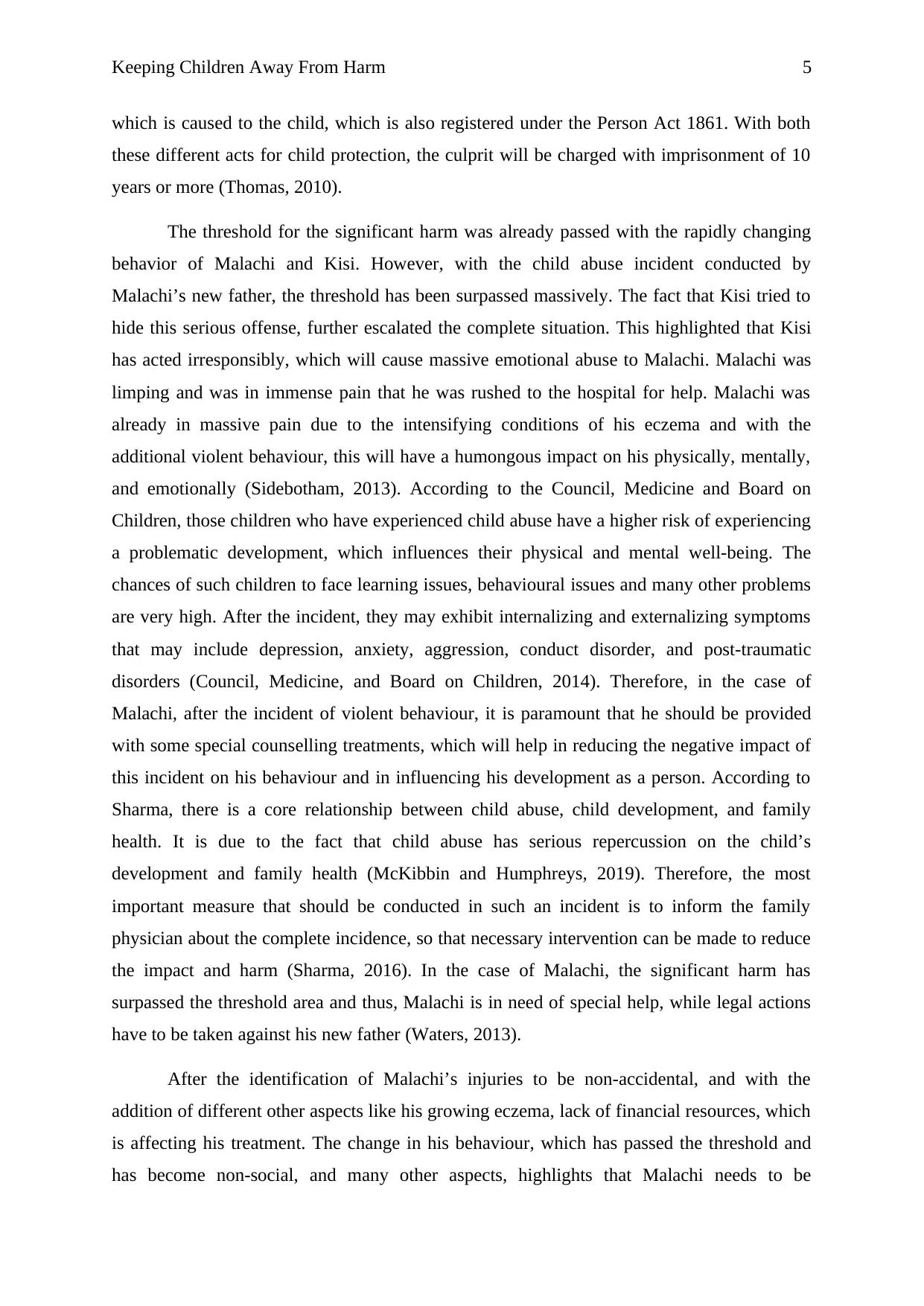
Keeping Children Away From Harm 5
which is caused to the child, which is also registered under the Person Act 1861. With both
these different acts for child protection, the culprit will be charged with imprisonment of 10
years or more (Thomas, 2010).
The threshold for the significant harm was already passed with the rapidly changing
behavior of Malachi and Kisi. However, with the child abuse incident conducted by
Malachi’s new father, the threshold has been surpassed massively. The fact that Kisi tried to
hide this serious offense, further escalated the complete situation. This highlighted that Kisi
has acted irresponsibly, which will cause massive emotional abuse to Malachi. Malachi was
limping and was in immense pain that he was rushed to the hospital for help. Malachi was
already in massive pain due to the intensifying conditions of his eczema and with the
additional violent behaviour, this will have a humongous impact on his physically, mentally,
and emotionally (Sidebotham, 2013). According to the Council, Medicine and Board on
Children, those children who have experienced child abuse have a higher risk of experiencing
a problematic development, which influences their physical and mental well-being. The
chances of such children to face learning issues, behavioural issues and many other problems
are very high. After the incident, they may exhibit internalizing and externalizing symptoms
that may include depression, anxiety, aggression, conduct disorder, and post-traumatic
disorders (Council, Medicine, and Board on Children, 2014). Therefore, in the case of
Malachi, after the incident of violent behaviour, it is paramount that he should be provided
with some special counselling treatments, which will help in reducing the negative impact of
this incident on his behaviour and in influencing his development as a person. According to
Sharma, there is a core relationship between child abuse, child development, and family
health. It is due to the fact that child abuse has serious repercussion on the child’s
development and family health (McKibbin and Humphreys, 2019). Therefore, the most
important measure that should be conducted in such an incident is to inform the family
physician about the complete incidence, so that necessary intervention can be made to reduce
the impact and harm (Sharma, 2016). In the case of Malachi, the significant harm has
surpassed the threshold area and thus, Malachi is in need of special help, while legal actions
have to be taken against his new father (Waters, 2013).
After the identification of Malachi’s injuries to be non-accidental, and with the
addition of different other aspects like his growing eczema, lack of financial resources, which
is affecting his treatment. The change in his behaviour, which has passed the threshold and
has become non-social, and many other aspects, highlights that Malachi needs to be
which is caused to the child, which is also registered under the Person Act 1861. With both
these different acts for child protection, the culprit will be charged with imprisonment of 10
years or more (Thomas, 2010).
The threshold for the significant harm was already passed with the rapidly changing
behavior of Malachi and Kisi. However, with the child abuse incident conducted by
Malachi’s new father, the threshold has been surpassed massively. The fact that Kisi tried to
hide this serious offense, further escalated the complete situation. This highlighted that Kisi
has acted irresponsibly, which will cause massive emotional abuse to Malachi. Malachi was
limping and was in immense pain that he was rushed to the hospital for help. Malachi was
already in massive pain due to the intensifying conditions of his eczema and with the
additional violent behaviour, this will have a humongous impact on his physically, mentally,
and emotionally (Sidebotham, 2013). According to the Council, Medicine and Board on
Children, those children who have experienced child abuse have a higher risk of experiencing
a problematic development, which influences their physical and mental well-being. The
chances of such children to face learning issues, behavioural issues and many other problems
are very high. After the incident, they may exhibit internalizing and externalizing symptoms
that may include depression, anxiety, aggression, conduct disorder, and post-traumatic
disorders (Council, Medicine, and Board on Children, 2014). Therefore, in the case of
Malachi, after the incident of violent behaviour, it is paramount that he should be provided
with some special counselling treatments, which will help in reducing the negative impact of
this incident on his behaviour and in influencing his development as a person. According to
Sharma, there is a core relationship between child abuse, child development, and family
health. It is due to the fact that child abuse has serious repercussion on the child’s
development and family health (McKibbin and Humphreys, 2019). Therefore, the most
important measure that should be conducted in such an incident is to inform the family
physician about the complete incidence, so that necessary intervention can be made to reduce
the impact and harm (Sharma, 2016). In the case of Malachi, the significant harm has
surpassed the threshold area and thus, Malachi is in need of special help, while legal actions
have to be taken against his new father (Waters, 2013).
After the identification of Malachi’s injuries to be non-accidental, and with the
addition of different other aspects like his growing eczema, lack of financial resources, which
is affecting his treatment. The change in his behaviour, which has passed the threshold and
has become non-social, and many other aspects, highlights that Malachi needs to be
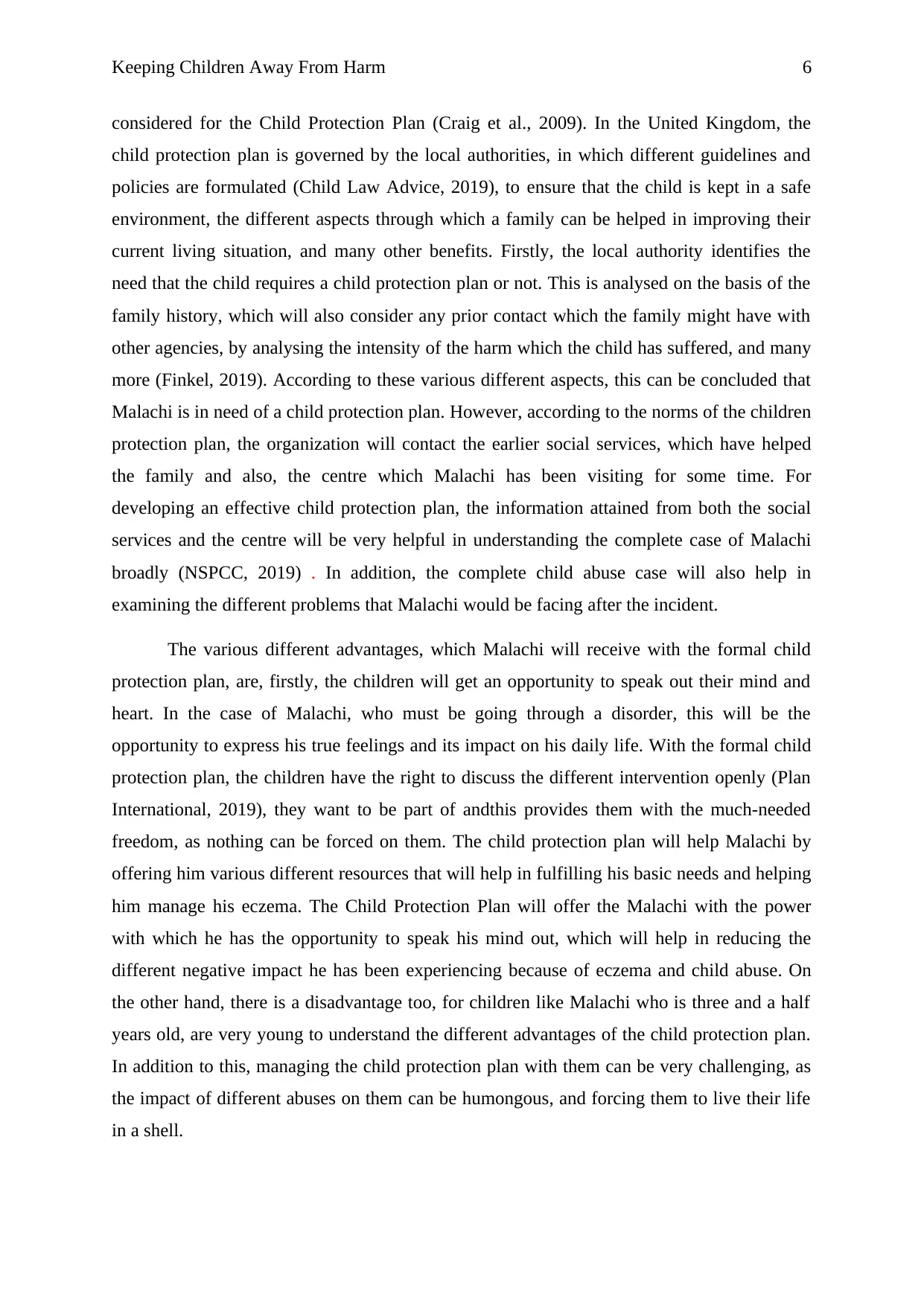
Keeping Children Away From Harm 6
considered for the Child Protection Plan (Craig et al., 2009). In the United Kingdom, the
child protection plan is governed by the local authorities, in which different guidelines and
policies are formulated (Child Law Advice, 2019), to ensure that the child is kept in a safe
environment, the different aspects through which a family can be helped in improving their
current living situation, and many other benefits. Firstly, the local authority identifies the
need that the child requires a child protection plan or not. This is analysed on the basis of the
family history, which will also consider any prior contact which the family might have with
other agencies, by analysing the intensity of the harm which the child has suffered, and many
more (Finkel, 2019). According to these various different aspects, this can be concluded that
Malachi is in need of a child protection plan. However, according to the norms of the children
protection plan, the organization will contact the earlier social services, which have helped
the family and also, the centre which Malachi has been visiting for some time. For
developing an effective child protection plan, the information attained from both the social
services and the centre will be very helpful in understanding the complete case of Malachi
broadly (NSPCC, 2019) . In addition, the complete child abuse case will also help in
examining the different problems that Malachi would be facing after the incident.
The various different advantages, which Malachi will receive with the formal child
protection plan, are, firstly, the children will get an opportunity to speak out their mind and
heart. In the case of Malachi, who must be going through a disorder, this will be the
opportunity to express his true feelings and its impact on his daily life. With the formal child
protection plan, the children have the right to discuss the different intervention openly (Plan
International, 2019), they want to be part of andthis provides them with the much-needed
freedom, as nothing can be forced on them. The child protection plan will help Malachi by
offering him various different resources that will help in fulfilling his basic needs and helping
him manage his eczema. The Child Protection Plan will offer the Malachi with the power
with which he has the opportunity to speak his mind out, which will help in reducing the
different negative impact he has been experiencing because of eczema and child abuse. On
the other hand, there is a disadvantage too, for children like Malachi who is three and a half
years old, are very young to understand the different advantages of the child protection plan.
In addition to this, managing the child protection plan with them can be very challenging, as
the impact of different abuses on them can be humongous, and forcing them to live their life
in a shell.
considered for the Child Protection Plan (Craig et al., 2009). In the United Kingdom, the
child protection plan is governed by the local authorities, in which different guidelines and
policies are formulated (Child Law Advice, 2019), to ensure that the child is kept in a safe
environment, the different aspects through which a family can be helped in improving their
current living situation, and many other benefits. Firstly, the local authority identifies the
need that the child requires a child protection plan or not. This is analysed on the basis of the
family history, which will also consider any prior contact which the family might have with
other agencies, by analysing the intensity of the harm which the child has suffered, and many
more (Finkel, 2019). According to these various different aspects, this can be concluded that
Malachi is in need of a child protection plan. However, according to the norms of the children
protection plan, the organization will contact the earlier social services, which have helped
the family and also, the centre which Malachi has been visiting for some time. For
developing an effective child protection plan, the information attained from both the social
services and the centre will be very helpful in understanding the complete case of Malachi
broadly (NSPCC, 2019) . In addition, the complete child abuse case will also help in
examining the different problems that Malachi would be facing after the incident.
The various different advantages, which Malachi will receive with the formal child
protection plan, are, firstly, the children will get an opportunity to speak out their mind and
heart. In the case of Malachi, who must be going through a disorder, this will be the
opportunity to express his true feelings and its impact on his daily life. With the formal child
protection plan, the children have the right to discuss the different intervention openly (Plan
International, 2019), they want to be part of andthis provides them with the much-needed
freedom, as nothing can be forced on them. The child protection plan will help Malachi by
offering him various different resources that will help in fulfilling his basic needs and helping
him manage his eczema. The Child Protection Plan will offer the Malachi with the power
with which he has the opportunity to speak his mind out, which will help in reducing the
different negative impact he has been experiencing because of eczema and child abuse. On
the other hand, there is a disadvantage too, for children like Malachi who is three and a half
years old, are very young to understand the different advantages of the child protection plan.
In addition to this, managing the child protection plan with them can be very challenging, as
the impact of different abuses on them can be humongous, and forcing them to live their life
in a shell.
Paraphrase This Document
Need a fresh take? Get an instant paraphrase of this document with our AI Paraphraser
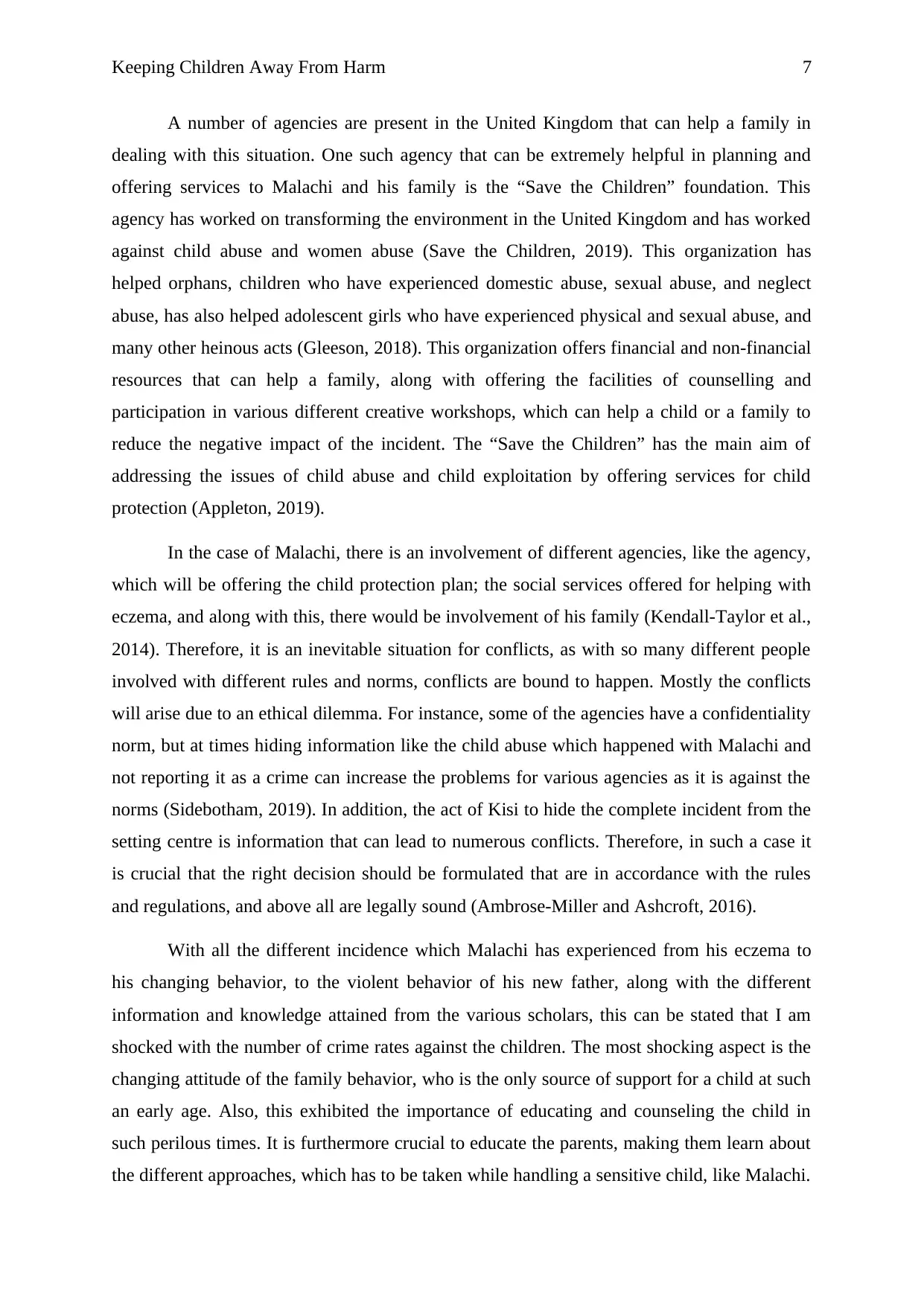
Keeping Children Away From Harm 7
A number of agencies are present in the United Kingdom that can help a family in
dealing with this situation. One such agency that can be extremely helpful in planning and
offering services to Malachi and his family is the “Save the Children” foundation. This
agency has worked on transforming the environment in the United Kingdom and has worked
against child abuse and women abuse (Save the Children, 2019). This organization has
helped orphans, children who have experienced domestic abuse, sexual abuse, and neglect
abuse, has also helped adolescent girls who have experienced physical and sexual abuse, and
many other heinous acts (Gleeson, 2018). This organization offers financial and non-financial
resources that can help a family, along with offering the facilities of counselling and
participation in various different creative workshops, which can help a child or a family to
reduce the negative impact of the incident. The “Save the Children” has the main aim of
addressing the issues of child abuse and child exploitation by offering services for child
protection (Appleton, 2019).
In the case of Malachi, there is an involvement of different agencies, like the agency,
which will be offering the child protection plan; the social services offered for helping with
eczema, and along with this, there would be involvement of his family (Kendall-Taylor et al.,
2014). Therefore, it is an inevitable situation for conflicts, as with so many different people
involved with different rules and norms, conflicts are bound to happen. Mostly the conflicts
will arise due to an ethical dilemma. For instance, some of the agencies have a confidentiality
norm, but at times hiding information like the child abuse which happened with Malachi and
not reporting it as a crime can increase the problems for various agencies as it is against the
norms (Sidebotham, 2019). In addition, the act of Kisi to hide the complete incident from the
setting centre is information that can lead to numerous conflicts. Therefore, in such a case it
is crucial that the right decision should be formulated that are in accordance with the rules
and regulations, and above all are legally sound (Ambrose-Miller and Ashcroft, 2016).
With all the different incidence which Malachi has experienced from his eczema to
his changing behavior, to the violent behavior of his new father, along with the different
information and knowledge attained from the various scholars, this can be stated that I am
shocked with the number of crime rates against the children. The most shocking aspect is the
changing attitude of the family behavior, who is the only source of support for a child at such
an early age. Also, this exhibited the importance of educating and counseling the child in
such perilous times. It is furthermore crucial to educate the parents, making them learn about
the different approaches, which has to be taken while handling a sensitive child, like Malachi.
A number of agencies are present in the United Kingdom that can help a family in
dealing with this situation. One such agency that can be extremely helpful in planning and
offering services to Malachi and his family is the “Save the Children” foundation. This
agency has worked on transforming the environment in the United Kingdom and has worked
against child abuse and women abuse (Save the Children, 2019). This organization has
helped orphans, children who have experienced domestic abuse, sexual abuse, and neglect
abuse, has also helped adolescent girls who have experienced physical and sexual abuse, and
many other heinous acts (Gleeson, 2018). This organization offers financial and non-financial
resources that can help a family, along with offering the facilities of counselling and
participation in various different creative workshops, which can help a child or a family to
reduce the negative impact of the incident. The “Save the Children” has the main aim of
addressing the issues of child abuse and child exploitation by offering services for child
protection (Appleton, 2019).
In the case of Malachi, there is an involvement of different agencies, like the agency,
which will be offering the child protection plan; the social services offered for helping with
eczema, and along with this, there would be involvement of his family (Kendall-Taylor et al.,
2014). Therefore, it is an inevitable situation for conflicts, as with so many different people
involved with different rules and norms, conflicts are bound to happen. Mostly the conflicts
will arise due to an ethical dilemma. For instance, some of the agencies have a confidentiality
norm, but at times hiding information like the child abuse which happened with Malachi and
not reporting it as a crime can increase the problems for various agencies as it is against the
norms (Sidebotham, 2019). In addition, the act of Kisi to hide the complete incident from the
setting centre is information that can lead to numerous conflicts. Therefore, in such a case it
is crucial that the right decision should be formulated that are in accordance with the rules
and regulations, and above all are legally sound (Ambrose-Miller and Ashcroft, 2016).
With all the different incidence which Malachi has experienced from his eczema to
his changing behavior, to the violent behavior of his new father, along with the different
information and knowledge attained from the various scholars, this can be stated that I am
shocked with the number of crime rates against the children. The most shocking aspect is the
changing attitude of the family behavior, who is the only source of support for a child at such
an early age. Also, this exhibited the importance of educating and counseling the child in
such perilous times. It is furthermore crucial to educate the parents, making them learn about
the different approaches, which has to be taken while handling a sensitive child, like Malachi.
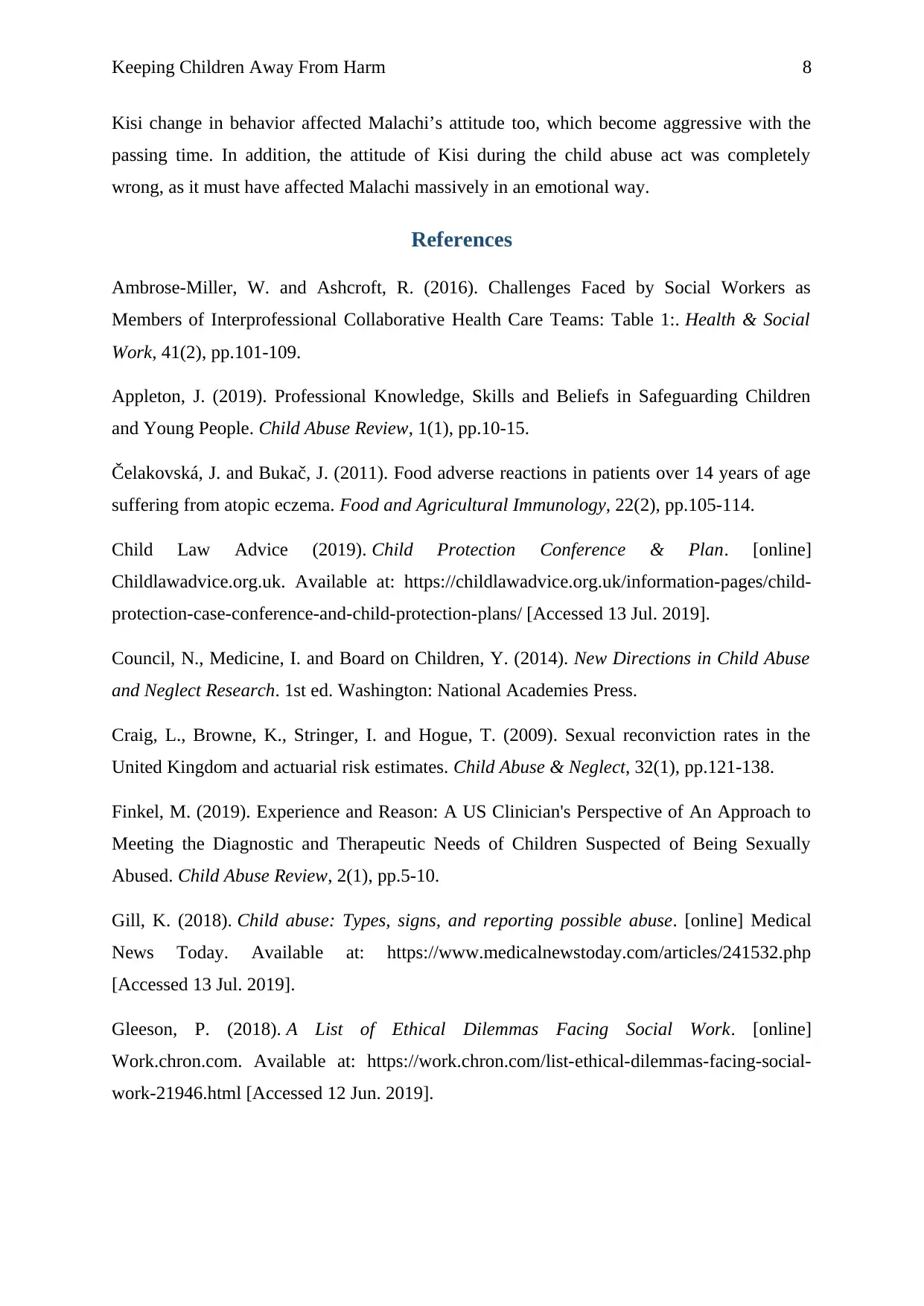
Keeping Children Away From Harm 8
Kisi change in behavior affected Malachi’s attitude too, which become aggressive with the
passing time. In addition, the attitude of Kisi during the child abuse act was completely
wrong, as it must have affected Malachi massively in an emotional way.
References
Ambrose-Miller, W. and Ashcroft, R. (2016). Challenges Faced by Social Workers as
Members of Interprofessional Collaborative Health Care Teams: Table 1:. Health & Social
Work, 41(2), pp.101-109.
Appleton, J. (2019). Professional Knowledge, Skills and Beliefs in Safeguarding Children
and Young People. Child Abuse Review, 1(1), pp.10-15.
Čelakovská, J. and Bukač, J. (2011). Food adverse reactions in patients over 14 years of age
suffering from atopic eczema. Food and Agricultural Immunology, 22(2), pp.105-114.
Child Law Advice (2019). Child Protection Conference & Plan. [online]
Childlawadvice.org.uk. Available at: https://childlawadvice.org.uk/information-pages/child-
protection-case-conference-and-child-protection-plans/ [Accessed 13 Jul. 2019].
Council, N., Medicine, I. and Board on Children, Y. (2014). New Directions in Child Abuse
and Neglect Research. 1st ed. Washington: National Academies Press.
Craig, L., Browne, K., Stringer, I. and Hogue, T. (2009). Sexual reconviction rates in the
United Kingdom and actuarial risk estimates. Child Abuse & Neglect, 32(1), pp.121-138.
Finkel, M. (2019). Experience and Reason: A US Clinician's Perspective of An Approach to
Meeting the Diagnostic and Therapeutic Needs of Children Suspected of Being Sexually
Abused. Child Abuse Review, 2(1), pp.5-10.
Gill, K. (2018). Child abuse: Types, signs, and reporting possible abuse. [online] Medical
News Today. Available at: https://www.medicalnewstoday.com/articles/241532.php
[Accessed 13 Jul. 2019].
Gleeson, P. (2018). A List of Ethical Dilemmas Facing Social Work. [online]
Work.chron.com. Available at: https://work.chron.com/list-ethical-dilemmas-facing-social-
work-21946.html [Accessed 12 Jun. 2019].
Kisi change in behavior affected Malachi’s attitude too, which become aggressive with the
passing time. In addition, the attitude of Kisi during the child abuse act was completely
wrong, as it must have affected Malachi massively in an emotional way.
References
Ambrose-Miller, W. and Ashcroft, R. (2016). Challenges Faced by Social Workers as
Members of Interprofessional Collaborative Health Care Teams: Table 1:. Health & Social
Work, 41(2), pp.101-109.
Appleton, J. (2019). Professional Knowledge, Skills and Beliefs in Safeguarding Children
and Young People. Child Abuse Review, 1(1), pp.10-15.
Čelakovská, J. and Bukač, J. (2011). Food adverse reactions in patients over 14 years of age
suffering from atopic eczema. Food and Agricultural Immunology, 22(2), pp.105-114.
Child Law Advice (2019). Child Protection Conference & Plan. [online]
Childlawadvice.org.uk. Available at: https://childlawadvice.org.uk/information-pages/child-
protection-case-conference-and-child-protection-plans/ [Accessed 13 Jul. 2019].
Council, N., Medicine, I. and Board on Children, Y. (2014). New Directions in Child Abuse
and Neglect Research. 1st ed. Washington: National Academies Press.
Craig, L., Browne, K., Stringer, I. and Hogue, T. (2009). Sexual reconviction rates in the
United Kingdom and actuarial risk estimates. Child Abuse & Neglect, 32(1), pp.121-138.
Finkel, M. (2019). Experience and Reason: A US Clinician's Perspective of An Approach to
Meeting the Diagnostic and Therapeutic Needs of Children Suspected of Being Sexually
Abused. Child Abuse Review, 2(1), pp.5-10.
Gill, K. (2018). Child abuse: Types, signs, and reporting possible abuse. [online] Medical
News Today. Available at: https://www.medicalnewstoday.com/articles/241532.php
[Accessed 13 Jul. 2019].
Gleeson, P. (2018). A List of Ethical Dilemmas Facing Social Work. [online]
Work.chron.com. Available at: https://work.chron.com/list-ethical-dilemmas-facing-social-
work-21946.html [Accessed 12 Jun. 2019].
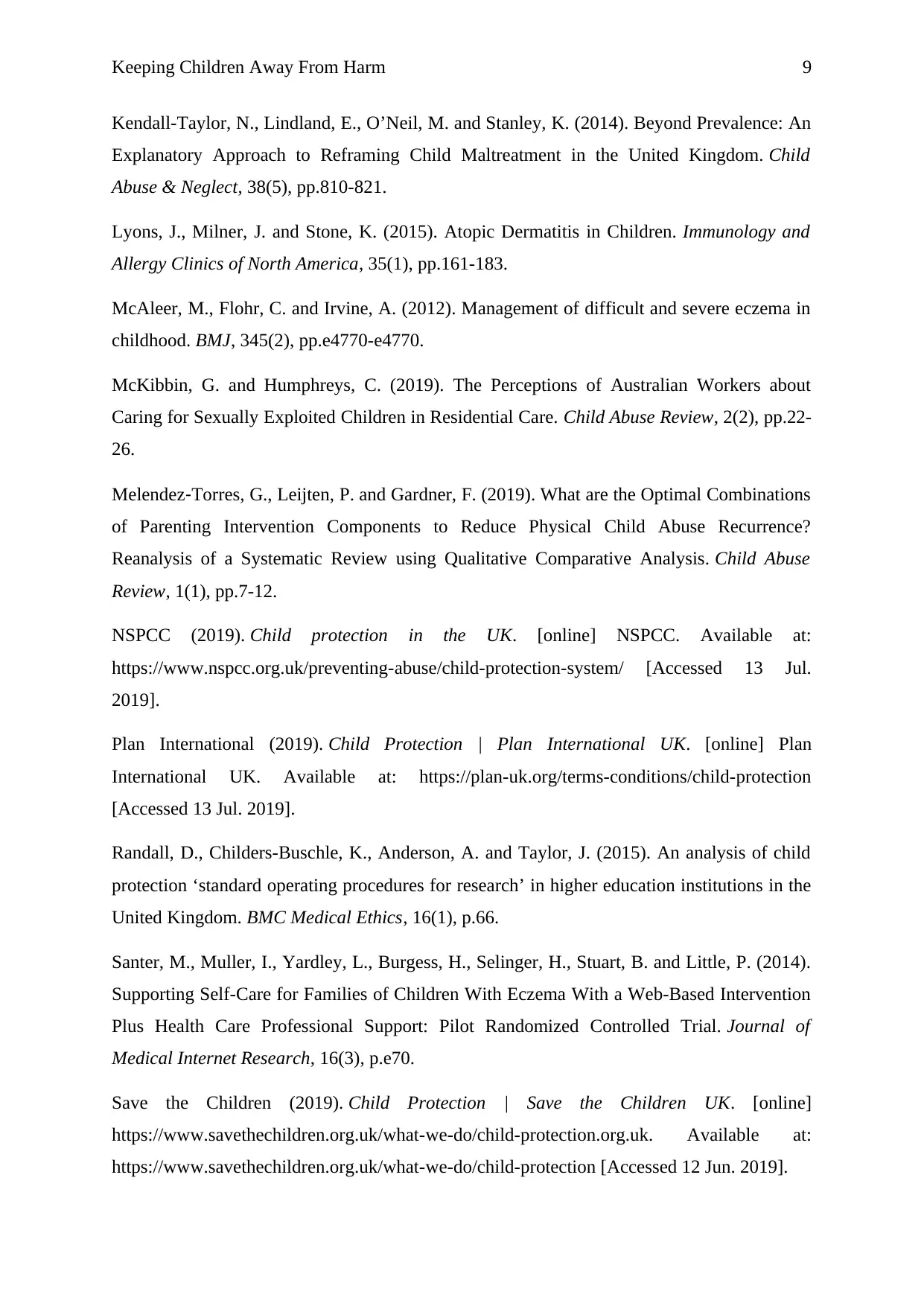
Keeping Children Away From Harm 9
Kendall-Taylor, N., Lindland, E., O’Neil, M. and Stanley, K. (2014). Beyond Prevalence: An
Explanatory Approach to Reframing Child Maltreatment in the United Kingdom. Child
Abuse & Neglect, 38(5), pp.810-821.
Lyons, J., Milner, J. and Stone, K. (2015). Atopic Dermatitis in Children. Immunology and
Allergy Clinics of North America, 35(1), pp.161-183.
McAleer, M., Flohr, C. and Irvine, A. (2012). Management of difficult and severe eczema in
childhood. BMJ, 345(2), pp.e4770-e4770.
McKibbin, G. and Humphreys, C. (2019). The Perceptions of Australian Workers about
Caring for Sexually Exploited Children in Residential Care. Child Abuse Review, 2(2), pp.22-
26.
Melendez‐Torres, G., Leijten, P. and Gardner, F. (2019). What are the Optimal Combinations
of Parenting Intervention Components to Reduce Physical Child Abuse Recurrence?
Reanalysis of a Systematic Review using Qualitative Comparative Analysis. Child Abuse
Review, 1(1), pp.7-12.
NSPCC (2019). Child protection in the UK. [online] NSPCC. Available at:
https://www.nspcc.org.uk/preventing-abuse/child-protection-system/ [Accessed 13 Jul.
2019].
Plan International (2019). Child Protection | Plan International UK. [online] Plan
International UK. Available at: https://plan-uk.org/terms-conditions/child-protection
[Accessed 13 Jul. 2019].
Randall, D., Childers-Buschle, K., Anderson, A. and Taylor, J. (2015). An analysis of child
protection ‘standard operating procedures for research’ in higher education institutions in the
United Kingdom. BMC Medical Ethics, 16(1), p.66.
Santer, M., Muller, I., Yardley, L., Burgess, H., Selinger, H., Stuart, B. and Little, P. (2014).
Supporting Self-Care for Families of Children With Eczema With a Web-Based Intervention
Plus Health Care Professional Support: Pilot Randomized Controlled Trial. Journal of
Medical Internet Research, 16(3), p.e70.
Save the Children (2019). Child Protection | Save the Children UK. [online]
https://www.savethechildren.org.uk/what-we-do/child-protection.org.uk. Available at:
https://www.savethechildren.org.uk/what-we-do/child-protection [Accessed 12 Jun. 2019].
Kendall-Taylor, N., Lindland, E., O’Neil, M. and Stanley, K. (2014). Beyond Prevalence: An
Explanatory Approach to Reframing Child Maltreatment in the United Kingdom. Child
Abuse & Neglect, 38(5), pp.810-821.
Lyons, J., Milner, J. and Stone, K. (2015). Atopic Dermatitis in Children. Immunology and
Allergy Clinics of North America, 35(1), pp.161-183.
McAleer, M., Flohr, C. and Irvine, A. (2012). Management of difficult and severe eczema in
childhood. BMJ, 345(2), pp.e4770-e4770.
McKibbin, G. and Humphreys, C. (2019). The Perceptions of Australian Workers about
Caring for Sexually Exploited Children in Residential Care. Child Abuse Review, 2(2), pp.22-
26.
Melendez‐Torres, G., Leijten, P. and Gardner, F. (2019). What are the Optimal Combinations
of Parenting Intervention Components to Reduce Physical Child Abuse Recurrence?
Reanalysis of a Systematic Review using Qualitative Comparative Analysis. Child Abuse
Review, 1(1), pp.7-12.
NSPCC (2019). Child protection in the UK. [online] NSPCC. Available at:
https://www.nspcc.org.uk/preventing-abuse/child-protection-system/ [Accessed 13 Jul.
2019].
Plan International (2019). Child Protection | Plan International UK. [online] Plan
International UK. Available at: https://plan-uk.org/terms-conditions/child-protection
[Accessed 13 Jul. 2019].
Randall, D., Childers-Buschle, K., Anderson, A. and Taylor, J. (2015). An analysis of child
protection ‘standard operating procedures for research’ in higher education institutions in the
United Kingdom. BMC Medical Ethics, 16(1), p.66.
Santer, M., Muller, I., Yardley, L., Burgess, H., Selinger, H., Stuart, B. and Little, P. (2014).
Supporting Self-Care for Families of Children With Eczema With a Web-Based Intervention
Plus Health Care Professional Support: Pilot Randomized Controlled Trial. Journal of
Medical Internet Research, 16(3), p.e70.
Save the Children (2019). Child Protection | Save the Children UK. [online]
https://www.savethechildren.org.uk/what-we-do/child-protection.org.uk. Available at:
https://www.savethechildren.org.uk/what-we-do/child-protection [Accessed 12 Jun. 2019].
Secure Best Marks with AI Grader
Need help grading? Try our AI Grader for instant feedback on your assignments.
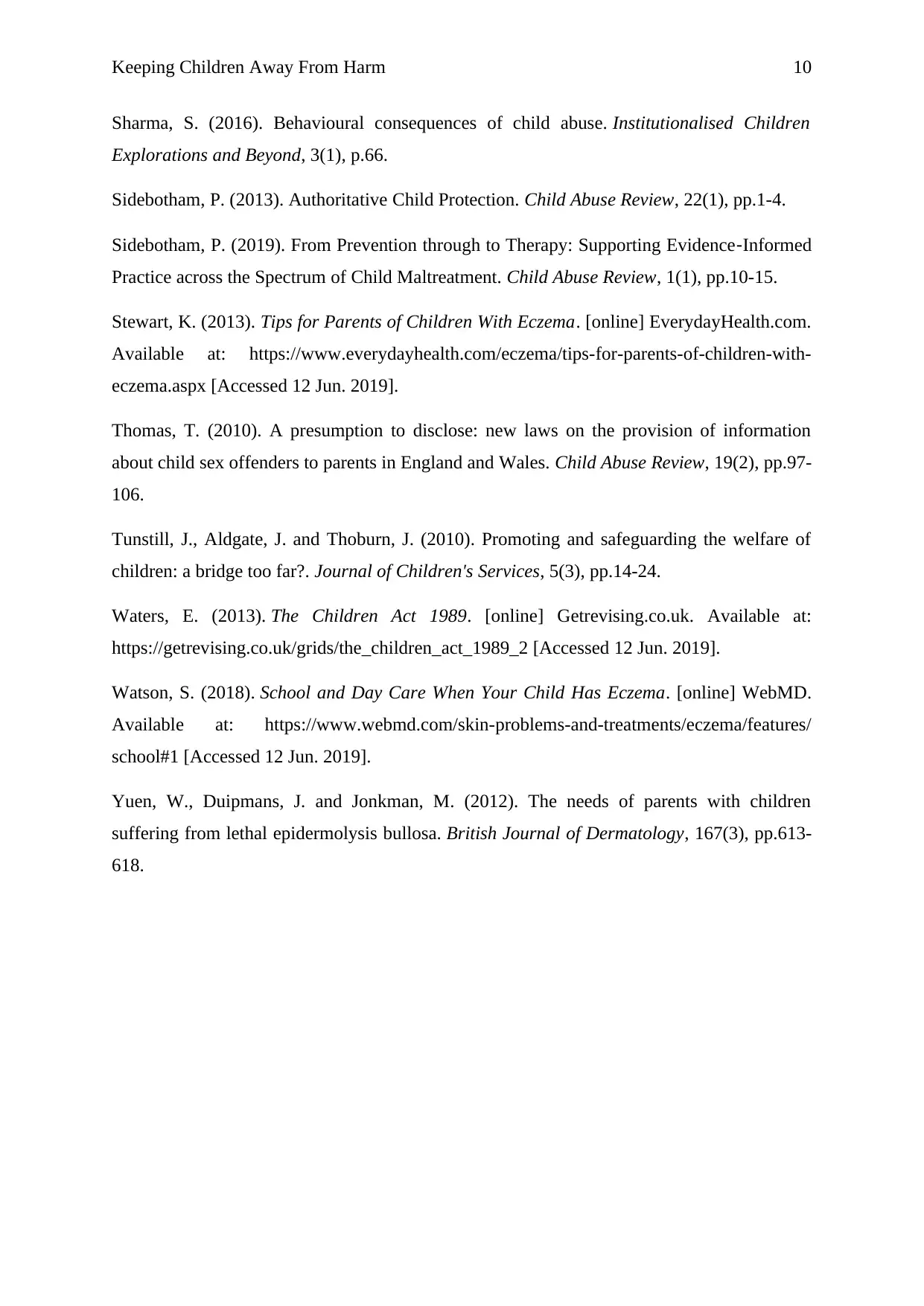
Keeping Children Away From Harm 10
Sharma, S. (2016). Behavioural consequences of child abuse. Institutionalised Children
Explorations and Beyond, 3(1), p.66.
Sidebotham, P. (2013). Authoritative Child Protection. Child Abuse Review, 22(1), pp.1-4.
Sidebotham, P. (2019). From Prevention through to Therapy: Supporting Evidence‐Informed
Practice across the Spectrum of Child Maltreatment. Child Abuse Review, 1(1), pp.10-15.
Stewart, K. (2013). Tips for Parents of Children With Eczema. [online] EverydayHealth.com.
Available at: https://www.everydayhealth.com/eczema/tips-for-parents-of-children-with-
eczema.aspx [Accessed 12 Jun. 2019].
Thomas, T. (2010). A presumption to disclose: new laws on the provision of information
about child sex offenders to parents in England and Wales. Child Abuse Review, 19(2), pp.97-
106.
Tunstill, J., Aldgate, J. and Thoburn, J. (2010). Promoting and safeguarding the welfare of
children: a bridge too far?. Journal of Children's Services, 5(3), pp.14-24.
Waters, E. (2013). The Children Act 1989. [online] Getrevising.co.uk. Available at:
https://getrevising.co.uk/grids/the_children_act_1989_2 [Accessed 12 Jun. 2019].
Watson, S. (2018). School and Day Care When Your Child Has Eczema. [online] WebMD.
Available at: https://www.webmd.com/skin-problems-and-treatments/eczema/features/
school#1 [Accessed 12 Jun. 2019].
Yuen, W., Duipmans, J. and Jonkman, M. (2012). The needs of parents with children
suffering from lethal epidermolysis bullosa. British Journal of Dermatology, 167(3), pp.613-
618.
Sharma, S. (2016). Behavioural consequences of child abuse. Institutionalised Children
Explorations and Beyond, 3(1), p.66.
Sidebotham, P. (2013). Authoritative Child Protection. Child Abuse Review, 22(1), pp.1-4.
Sidebotham, P. (2019). From Prevention through to Therapy: Supporting Evidence‐Informed
Practice across the Spectrum of Child Maltreatment. Child Abuse Review, 1(1), pp.10-15.
Stewart, K. (2013). Tips for Parents of Children With Eczema. [online] EverydayHealth.com.
Available at: https://www.everydayhealth.com/eczema/tips-for-parents-of-children-with-
eczema.aspx [Accessed 12 Jun. 2019].
Thomas, T. (2010). A presumption to disclose: new laws on the provision of information
about child sex offenders to parents in England and Wales. Child Abuse Review, 19(2), pp.97-
106.
Tunstill, J., Aldgate, J. and Thoburn, J. (2010). Promoting and safeguarding the welfare of
children: a bridge too far?. Journal of Children's Services, 5(3), pp.14-24.
Waters, E. (2013). The Children Act 1989. [online] Getrevising.co.uk. Available at:
https://getrevising.co.uk/grids/the_children_act_1989_2 [Accessed 12 Jun. 2019].
Watson, S. (2018). School and Day Care When Your Child Has Eczema. [online] WebMD.
Available at: https://www.webmd.com/skin-problems-and-treatments/eczema/features/
school#1 [Accessed 12 Jun. 2019].
Yuen, W., Duipmans, J. and Jonkman, M. (2012). The needs of parents with children
suffering from lethal epidermolysis bullosa. British Journal of Dermatology, 167(3), pp.613-
618.
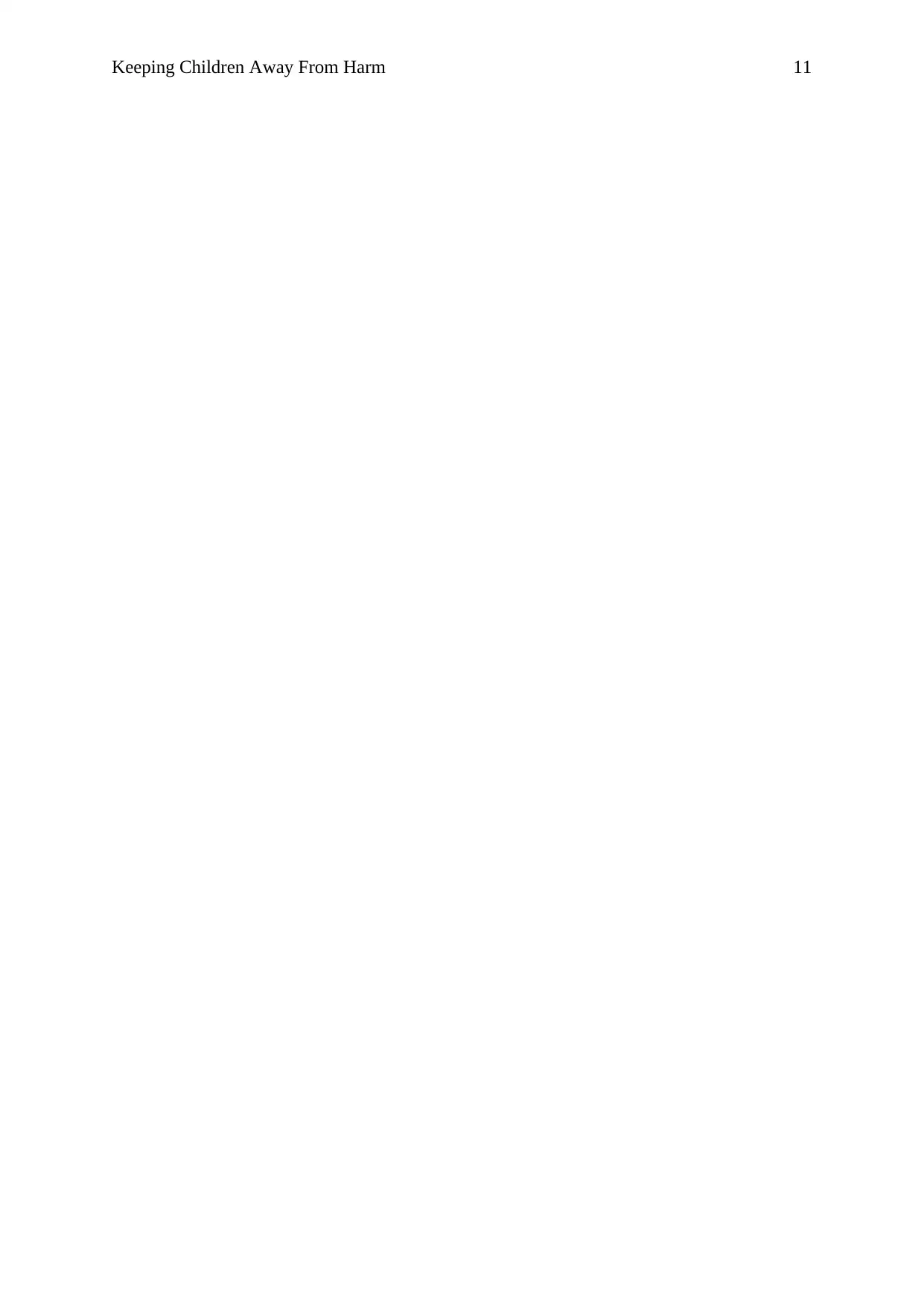
Keeping Children Away From Harm 11
1 out of 12
Related Documents
Your All-in-One AI-Powered Toolkit for Academic Success.
+13062052269
info@desklib.com
Available 24*7 on WhatsApp / Email
![[object Object]](/_next/static/media/star-bottom.7253800d.svg)
Unlock your academic potential
© 2024 | Zucol Services PVT LTD | All rights reserved.





